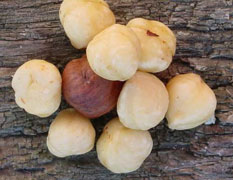


Home
Flowers &
Indoor Plants
Fruits & Nuts
Ornamentals
Vegetables
Special Topics
Resources
Glossary

 |
What about it? The filbert is commonly known as the hazelnut. Ninety-five percent of the world's crop is grown in Turkey, Italy, and Spain; most of the filberts grown in this country come from Oregon and Washington. Although there is an American filbert, what is commonly available commercially is the European species. The European filbert is an attractive tree with large dark green leaves. Because of its tendency to have multiple stems, it is often grown as an informal hedge or screen. The male flowers are catkins, and the female flowers are small and inconspicuous. Although the trees are hardy, these flowers appear in very early spring, and can be touched by frost. What is it used for? Many people enjoy the filbert as an accent plant. Its large leaves and interesting nut coverings add to the ornamental quality of the plant. Filberts are enjoyed as a roasted and salted "munchie," or in baked goods, casseroles, stuffings, and vegetable dishes. Where does it grow? How do we grow it?Filberts need full sun, and perform well in loamy soils with good drainage. Because of the possibility of frost injury, a protected location will help to ensure a larger crop. Pruning of suckers will be necessary if you are growing the filbert as a single stemmed tree. What are its primary problems? Big bud mite, which causes swelling and dropping of buds in spring, seems to cause the main problems in filberts. White fly and aphids can also occasionally cause problems. How do we harvest and store it? Filberts are picked by hand from the ground after they have fallen; be sure to get them before the squirrels do! After separating from the outside shell or husk, they will store for several months at cool, dry temperatures.
© Copyright, Department of Horticulture, Cornell University. |



